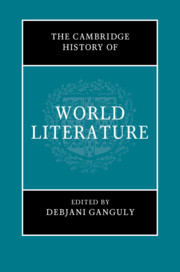Book contents
- The Cambridge History of World Literature
- The Cambridge History of World Literature
- Copyright page
- Contents
- Figures
- Contributors
- Acknowledgements
- Introduction
- Part I Genealogies
- Part II Thinking the World
- Part III Transregional Worlding
- Part IV Cartographic Shifts
- Part V World Literature and Translation
- Part VI Poetics, Genre, Intermediality
- Part VII Scales, Polysystems, Canons
- Part VIII Modes of Reading and Circulation
- Part IX The Worldly and the Planetary
- 44 Asylum Papers
- 45 Guantánamo Diary as World(ly) Testimony
- 46 The Nonhuman, the Posthuman, and the Universal
- 47 World Literature as Planetary Literature
- Index
- References
46 - The Nonhuman, the Posthuman, and the Universal
from Part IX - The Worldly and the Planetary
Published online by Cambridge University Press: 17 August 2021
- The Cambridge History of World Literature
- The Cambridge History of World Literature
- Copyright page
- Contents
- Figures
- Contributors
- Acknowledgements
- Introduction
- Part I Genealogies
- Part II Thinking the World
- Part III Transregional Worlding
- Part IV Cartographic Shifts
- Part V World Literature and Translation
- Part VI Poetics, Genre, Intermediality
- Part VII Scales, Polysystems, Canons
- Part VIII Modes of Reading and Circulation
- Part IX The Worldly and the Planetary
- 44 Asylum Papers
- 45 Guantánamo Diary as World(ly) Testimony
- 46 The Nonhuman, the Posthuman, and the Universal
- 47 World Literature as Planetary Literature
- Index
- References
Summary
The non-human has a long history of being represented in literature. Plants, animals, spirits, gods and, more recently, machines have been given agency and helped create enchanted visions of the world. The non-human has also been important in presenting universally recognizable characters, which have been central to the influence of certain genres and works in world literature, e.g. fairy tales and magical realism. This influence continues to be important but it has been supplemented with a new focus on the posthuman. Even though the idea of a succession to humanity would have been a logical consequence of Darwinism, it is has become a more pressing issue with the development of new technologies. Instead of apocalyptic visions of the end of the world, which have been central to not least foundational religious systems, the idea of the posthuman conjures up a new era for better or worse. Science fiction is rife with posthuman figures but also mainstream authors are taking up ideas of radically changed conditions for living. Literature’s responses have been manifold and have explored the once dated question of universalism under the influence of very concrete scenarios of change, and with a renewed sense of highlighting essential human traits in the Anthropocene.
- Type
- Chapter
- Information
- The Cambridge History of World Literature , pp. 909 - 923Publisher: Cambridge University PressPrint publication year: 2021
References
- 1
- Cited by



